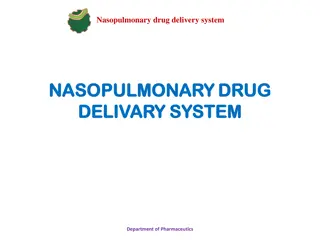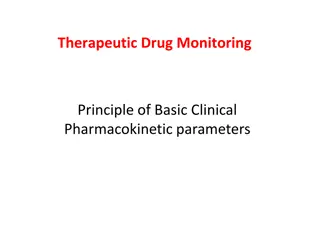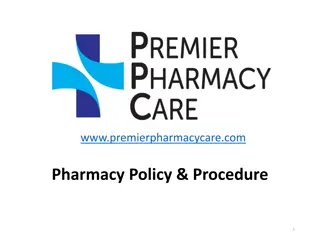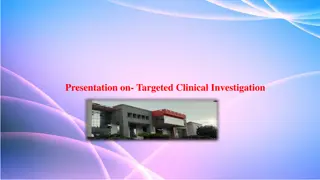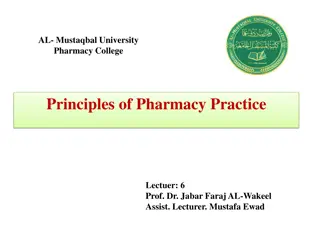Principles of Pharmacy Practice - Drug Dosing Guidelines and Measurements
Understanding drug dosing is crucial in pharmacy practice. This lecture covers various aspects of doses, including adult and pediatric doses, dosage regimens, median effective and toxic doses, loading and maintenance doses, and prophylactic and therapeutic doses. Dose measurements in institutional settings are also discussed, highlighting the importance of accurate administration. The content provides valuable insights into the calculations and considerations involved in determining appropriate drug doses for patients.
Uploaded on Sep 11, 2024 | 9 Views
Download Presentation

Please find below an Image/Link to download the presentation.
The content on the website is provided AS IS for your information and personal use only. It may not be sold, licensed, or shared on other websites without obtaining consent from the author.If you encounter any issues during the download, it is possible that the publisher has removed the file from their server.
You are allowed to download the files provided on this website for personal or commercial use, subject to the condition that they are used lawfully. All files are the property of their respective owners.
The content on the website is provided AS IS for your information and personal use only. It may not be sold, licensed, or shared on other websites without obtaining consent from the author.
E N D
Presentation Transcript
Principles of pharmacy practice Lec 1 Lecturer Dr Athmar Dhahir Habeeb Al-Shohani PhD in industrial pharmacy and pharmaceutical formulations athmar1978@uomustansiriyah.edu.iq athmar1978@yahoo.com athmar.habeeb.12@ucl.ac.uk
calculation of doses The dose of a drug is the quantitative amount administered or taken by a patient for the intended medicinal effect. The dose may be expressed as a single dose, the amount taken at one time a daily dose a total dose, the amount taken during the course of therapy. A daily dose may be subdivided and taken in divided doses, two or more times per day depending on the characteristics of the drug and the illness. The schedule of dosing (e.g., four times per day for 10 days) is referred to as the dosage regimen
The usual adult dose of a drug is the amount that ordinarily produces the medicinal effect intended in the adult patient. The usual pediatric dose of a drug is the amount that ordinarily produces intended in infant or child patient. The usual adult and pediatric doses of a drug serve as a guide to physicians who may select to prescribe that dose initially or vary it depending on the assessed requirements of the particular patient. The usual dosage range for a drug indicates the quantitative range or amounts of the drug that may be prescribed within the medical practice. the medicinal effect guidelines of usual
The median effective dose of a drug is the amount that produces the desired intensity of effect in 50% of the individuals The median toxic dose of a drug is the amount that produces toxic effects in 50% of the individuals tested. The priming or loading dose is the dose that is larger-than-usual initial dose that may be required to achieve the desired blood drug level. The maintenance doses is the dose that is similar in amount to usual doses, are then administered according to the dosage regimen to sustain the desired drug blood levels or drug effects
Certain biologic or immunologic products, such as vaccines, may be administered in prophylactic doses to protect the patient from contracting a specific disease. Other antitoxins, may be administered in therapeutic doses to counter a disease after exposure or contraction. products, such as
Dose measurements In the institutional setting, doses are measured and administered by professional and paraprofessional personnel. A variety of measuring devices may be used, including calibrated cups for oral liquids and syringes and intravenous medication. sets for parenteral
In the home setting, the adult patient or a childs parent generally measures and administers dosage is usually measured in household terms, most commonly by the teaspoonful It should be noted that the capacities of household teaspoons may vary from 3 to 7 mL and those of tablespoons may vary from 15 to 22 mL. medication. Liquid and tablespoonful.
The Drop as a Unit of Measure Occasionally, the drop (abbreviated gtt) is used as a measure for small volumes of liquid medications. A drop does not represent a definite quantity, because drops of different liquids vary greatly. In an attempt to standardize the drop as a unit of volume, the United States Pharmacopeia defines the official medicine dropper as being constricted at the delivery end to a round opening with an external diameter of about 3 mm. The dropper, when held vertically, delivers water in drops, each of which weighs between 45 and 55 mg. Accordingly, the official dropper is calibrated to deliver approximately 20 drops of water per milliliter (i.e., 1 mL of water 1 gram or 1000 mg
If a pharmacist counted 40 drops of a medication in filling a graduate cylinder to the 2.5-mL mark, how many drops per milliliter did the dropper deliver?









